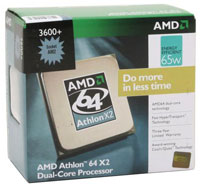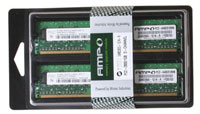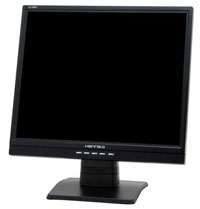Entry Level AMD
The great thing about purchasing a computer right now is that you can get a serious amount of performance for a reasonable price. Our entry level configuration will look to keep price as low as possible without making any major compromises. However, without spending a bit more money it is impossible to purchase a basic computer that will do everything well. The biggest compromise we are making is in the graphics department, where the use of integrated graphics basically means that gaming performance is going to be crippled. For the many people out there that don't care about games, that shouldn't present a problem. It is also relatively simple to upgrade a computer with a discrete graphics card in the future should the need/desire arise.
| AMD Entry Level System |
| Hardware |
Component |
Price |
Rebates |
| Processor |
Athlon 64 X2 3600+ AM2 (Brisbane 1.9GHz 2x512K) - Retail |
$72 |
|
| Motherboard |
ASUS M2A-VM (Socket AM2 AMD 690G) |
$77 |
|
| Memory |
WINTEC AMPO 2x512MB DDR2-800 (5-5-5-12 3AMD2800-1G1K-R) |
$65 |
|
| Hard Drive |
Western Digital Caviar SE16 WD2500KS 250GB 16MB |
$70 |
|
| Optical Drive |
Lite-On 20X DVD+R LH-20A1P-185 |
$34 |
|
| Case |
RAIDMAX APEX ATX-802BP with 450W PSU |
$65 |
|
| Display |
Hanns-G JC-199DPB 19" 8ms (1280x1024) |
$184 |
$40 |
| Speakers |
Cyber Acoustics CA3001WB 14 watts 2.1 Speakers |
$24 |
|
| Keyboard and Mouse |
Microsoft Comfort Curve 2000 B2L-00047 |
$28 |
|
| Operating System |
Windows MCE 2005 or Vista Home Premium (OEM) |
$115 |
|
| Bottom Line |
|
$734 |
$694 |
 |
Prices on AMD's dual core processors are now so low that we see little reason to avoid them. You could shave another $20 off the price by going with a single core Athlon 64 3000+, but that extra $20 buys you potentially twice as much performance. Dual core and multi-core processors are the future, and for those planning to purchase an inexpensive computer and use it for years to come we would just spend the extra money now. The Athlon X2 3600+ (Brisbane core) runs at 1.9GHz and comes with 512K cache per core. Do not confuse this with the 2.0GHz 256K version (Windsor core); the extra cache will almost certainly prove more useful than the extra 100 MHz. For those looking to really cut costs, if you don't want a dual core processor you might as well drop all the way down to the Sempron 64 3000+ (1.6GHz 256K cache) that costs a mere $33. Just don't expect that processor to handle the demands of many applications in three years' time.
 |
Perhaps the most difficult component to get right in any custom-built system is the motherboard. This is particularly true when looking at the budget sector. Buying the least expensive option is rarely the best course of action as features, reliability, stability, and performance can all be compromised. Luckily, the situation is generally better now than it has been in the past, and the integrated memory controller on AMD's processors usually means features and reliability are the only major concerns. For the current cost, the features and performance offered by AMD's 690G chipset put it at the top of our list. Besides a reasonably performing IGP solution - arguably the fastest currently available, though that isn't saying much - you can get VGA, DVI, as well as HDMI video outputs. The ASUS M2A-VM is a micro ATX solution with most of these features, available at a bargain price of only $77. Adding HDMI support will increase the price about $20. It certainly isn't one of the "everything but the kitchen sink" designs, though you can't usually find that without moving beyond the budget sector. This motherboard should also allow at least a moderate amount of overclocking if that's of interest, but that isn't a primary concern here.
 |
We chose DDR2-800 memory, simply because the cost is now at parity with other slower DDR2 memory (i.e. DDR2-667). Memory prices have also become much more reasonable since the beginning of the year, and we're back at the point where 2GB of RAM is available starting at just over $100. We decided not to go that far on entry level configuration, but if you're thinking about running Windows Vista as opposed to Windows XP we would strongly recommend upgrading the memory. On the bright side, at least even micro ATX motherboards are generally offering four DIMM slots these days. For the majority of users, memory timings and overclocking definitely aren't concerns in the budget sector, so we selected an inexpensive Wintec AMPO kit.
For the remaining items, we tried to keep the price down while keeping features and performance as high as possible. We could certainly trim things a bit further (for example getting a 160GB or even 80GB hard drive can save $15-$20), but we prefer to spend slightly more if possible. Getting a less expensive case is something else to consider, and of course those who prefer a little bling have plenty of budget options available. Provided you just want to stay with the basics, you can basically get any cheap case plus power supply and not have any difficulties, but we would still pay attention to user reviews and experiences and do a bit of research first.
 |
The only other major component remaining is the display, and here we were presented with several options. 17" LCDs are the least expensive choice right now, but once you factor in mail-in rebates it really only costs a few dollars more to get a 19" LCD. Some people might actually like the slightly smaller LCD for whatever reason, but we would definitely take a larger LCD first. Looking at the 19" LCDs, you then have to decide between standard aspect ratio and widescreen offerings. We like widescreens for the most part, but it seems like corners are being cut on the panels in order to keep costs down, and actual surface area is slightly larger on a standard aspect ratio display. Hanns G is one of many display manufacturers that most people aren't familiar with, but the reality is that there are only a few actual panel manufacturers. The quality of LCD panels has also reached the point where even the budget offerings look good and perform well. Long-term quality and support is a bit harder to judge, but the average user consensus is that this particular LCD is a very good budget option.














46 Comments
View All Comments
yyrkoon - Saturday, April 21, 2007 - link
I agree with Jarred somewhat, but I have always said: 'buy now, with upgrades in mind'. Meaning, if you are tired of waiting to upgrade, buy what you want now , based on what is currently availible, and make sure the components you choose, will give you as much flexability towards upgrading a CPU here, more memory there, a video card a year down the road, whatever.It has been sometime now, since you could buy parts, without feeling like you just wasted a wad of cash on something that is going to be outdated in ~6-12 months. SO . . . buy with upgrades in mind, which means everything I have said above, and 'research' on your behalf, since you are the only one who really kows what you really want/need.
JarredWalton - Friday, April 20, 2007 - link
I always tell people to wait until they don't feel they can wait any longer, because new products are always coming out. Intel will be releasing some new Core 2 models in the near future, cutting prices, etc. and AMD will be coming out with Barcelona at some point (sounding like maybe late July?) The same goes for NVIDIA and AMD/ATI. If you're ready to upgrade/buy and you need something right now, though, Then go ahead and take the plunge. I don't think Penryn is going to be as big a deal as the initial Core 2 launch - slightly faster, slightly cheaper, but nothing revolutionary (though the video encoding numbers are looking promising, and overclocking as well should be improved at least slightly).MarxMarvelous - Friday, April 20, 2007 - link
Nice article - just in time for me to start prepping for a new rig...In any case a couple of comments:
1) Re: Vista Drivers.
Personally I haven't had any issues at all with driver support. I'd say unless you have components that are 4+ years old you will be fine, especially if you are buying a brand new system.
2) Optical drive
Noticed that you are recomending a Pioneer across the board which is EIDE. SATA DVD-R drives are now around the same price and seem like a better choice.
http://www.newegg.com/product/product.asp?item=N82...">http://www.newegg.com/product/product.asp?item=N82...
JarredWalton - Friday, April 20, 2007 - link
Thanks for the heads up - I may have to get one of those for my next PC purchase. But I didn't recommend Pioneer across the board (Lite-On in the cheaper builds to save a few dollars). Personally, I just don't do enough burning to care all that much about optical drives these days. All of the drives I have work fine, and I haven't had a drive fail in a few years (knock on wood).As for Vista drivers, there are still games that have performance issues under Vista (OpenGL especially), and certain things like SLI support on various cards (6000 and 000 GeForce lines) is still missing last I heard. I know most game issues can be worked around with a bit of effort (I think there are some registry tweaks to get STALKER to run properly, for example), but that's not the same as just *working* properly. I don't like having to jump through hoops to get CrossFire or SLI to work, and I don't like constantly putzing about trying to get games to run properly. For those reasons, I'm generally shying away from Vista still. I also have at least one system that totally locks (and then BSODs on restart after the failed install) if I try to install the latest (or any version actually) X-Fi drivers, so I have to use integrated audio in Vista on that setup. I pulled the card and put it in a different system now.
It seems to me that Vista is fine for some people, but the more you push your system and applications, the more high-end your setup, the more problems people seem to have. It's mostly usable, but it still has a few more quirks than XP in my limited experience. Maybe in about six months I'll be ready to switch.
MarxMarvelous - Friday, April 20, 2007 - link
Whoops, I didn't look through all the configs so I didn't spot the Lite-On (I've pretty much decided on switching away from AMD :). Anyhow, I also don't do a whole lot of burning but was just happy to be able to switch away from those fat EIDE cables and also be a little more future proof in case I ever want to switch the drive to a mobo with no EIDE connectors (will happen someday!).As for the Vista drivers, yeah it sounds like you're definitely more on the edge (SLI/Crossfire, OpenGL, X-Fi, etc). All of the systems I'm running it on are pretty standard (either laptops or desktops using onboard audio + single video card). All have been pretty rock solid thus far (knock on wood).
ancolboy - Friday, April 20, 2007 - link
The article said it support 1333MHz, how so? MSI website never mention it. The article also said the board could allow overclock, but the board doesn't even allow user to change FSB frequency. Or did I miss something?JarredWalton - Friday, April 20, 2007 - link
Sorry - got some products mixed up and it didn't all come out right. The MSI board doesn't OC at all right now, you're right. I was debating between that and the Gigabyte S2 board, but the text didn't come out right. I've edited this now.ancolboy - Friday, April 20, 2007 - link
Thank you for clarifying it fast :) I am considering between intel or amd solution right now. Torn between performance and price, to top it up, linux compatibility.Hoping Gary's matx roundup (still writing it I guess) could help me decide which way to go.
JarredWalton - Friday, April 20, 2007 - link
If you want OC and performance, I'd say the Gigabyte S2 is probably the best bet. If you're okay with less performance, I'd seriously consider the Biostar and ASUS 690G options with an X2 processor. Quite handy with the HDMI ports as well, if that's something you're interested in.najames - Friday, April 20, 2007 - link
I would swap out the Asus M2A-VM for the Biostar TA690G for a few bucks more. It is a solid overclocker/undervolter if you are inclined. The layout on the Biostar allows for wide passive cooled video cards too, plus you can still use both PCI slots. I am actually strongly considering buying a second TA690G setup.I'd also add 2GB of RAM for only $35 more.